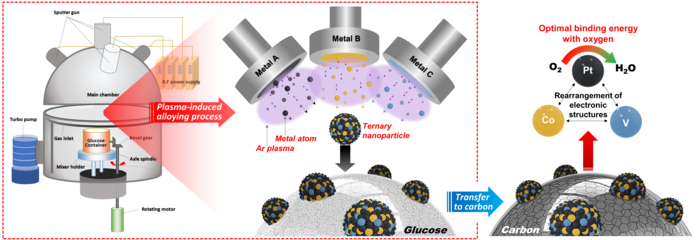A team of researchers in Korea has created metal nanoparticles that are capable of significantly boosting the performance of hydrogen fuel cell catalysts by employing semiconductor manufacturing technology.
 Illustration of the step-by-step synthesis process for the preparation of ternary nanoparticle catalysts and electron structure rearrangement by electron transfer between metal atoms. (Image Credit: Korea Institute of Science and Technology (KIST).
Illustration of the step-by-step synthesis process for the preparation of ternary nanoparticle catalysts and electron structure rearrangement by electron transfer between metal atoms. (Image Credit: Korea Institute of Science and Technology (KIST).
The Korea Institute of Science and Technology (KIST, President Seok Jin Yoon) reported that the research team guided by Dr. Sung Jong Yoo of the Hydrogen Fuel Cell Research Center has been successful in creating nanoparticles by a physical technique instead of the prevailing chemical reactions by employing the sputtering technology, which is a thin metal film deposition technology utilized in semiconductor manufacturing.
Metal nanoparticles have been explored in different fields over the past several years. Of late, metal nanoparticles have been gaining attention as a key catalyst for hydrogen fuel cells and water electrolysis systems to create hydrogen. Metal nanoparticles are mostly created through complex chemical reactions.
Furthermore, they are prepared using organic substances unsafe for the environment and humans. Thus, extra costs are unavoidably suffered for their treatment, and the synthesis conditions are tough. Consequently, a new nanoparticle synthesis technique that can surpass the inadequacies of the prevailing chemical synthesis is needed to launch the hydrogen energy regime.
The sputtering process used by the KIST researchers is a technology that coats a thin metal film in the course of the semiconductor manufacturing process. In this process, plasma is employed to cut large metals into nanoparticles, which are then placed on a substrate to develop a thin film.
The researchers prepared nanoparticles using “glucose,” a unique substrate that stopped the alteration of the metal nanoparticles to a thin film by using plasma during the process.
The synthesis technique applied the principle of physical vapor deposition using plasma instead of chemical reactions. Thus, metal nanoparticles could be made using this basic technique, surpassing the restrictions of the existing chemical synthesis approaches.
The development of new catalysts has been obstructed because the present chemical synthesis approaches restricted the types of metals that could be used as nanoparticles. Additionally, the synthesis conditions must be altered based on the type of metal. However, it has become feasible to create nanoparticles of more varied metals through the developed synthesis technique.
Moreover, if this technology is concurrently applied to two or more metals, alloy nanoparticles of different compositions can be created. This would pave the way for the creation of high-performance nanoparticle catalysts based on alloys of different compositions.
The KIST study team created a platinum-cobalt-vanadium alloy nanoparticle catalyst using this technology and applied it for the oxygen reduction reaction in hydrogen fuel cell electrodes. Consequently, the catalyst activity was seven and three times better than those of platinum and platinum-cobalt alloy catalysts that are marketed as catalysts for hydrogen fuel cells, respectively.
Additionally, the team examined the effect of the newly incorporated vanadium on other metals in the nanoparticles. They discovered that vanadium enhanced the catalyst performance by enhancing the platinum–oxygen bonding energy via computer simulation.
Through this research, we have developed a synthesis method based on a novel concept, which can be applied to research focused on metal nanoparticles toward the development of water electrolysis systems, solar cells, petrochemicals.
Dr Sung Jong Yoo, Study Lead, Hydrogen Fuel Cell Research Center, KIST
“We will strive to establish a complete hydrogen economy and develop carbon-neutral technology by applying alloy nanoparticles with new structures, which has been difficult to implement, to development eco-friendly energy technologies including hydrogen fuel cells,” Dr Sung Jong Yoo added.
Journal Reference:
Jang, I., et al. (2021) Plasma-induced alloying as a green technology for synthesizing ternary nanoparticles with an early transition metal. Nano Today. doi.org/10.1016/j.nantod.2021.101316.